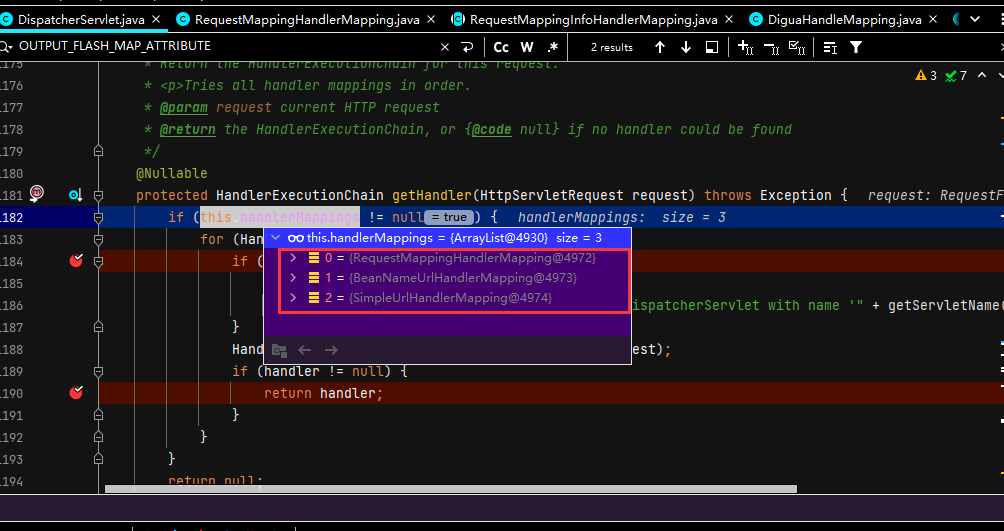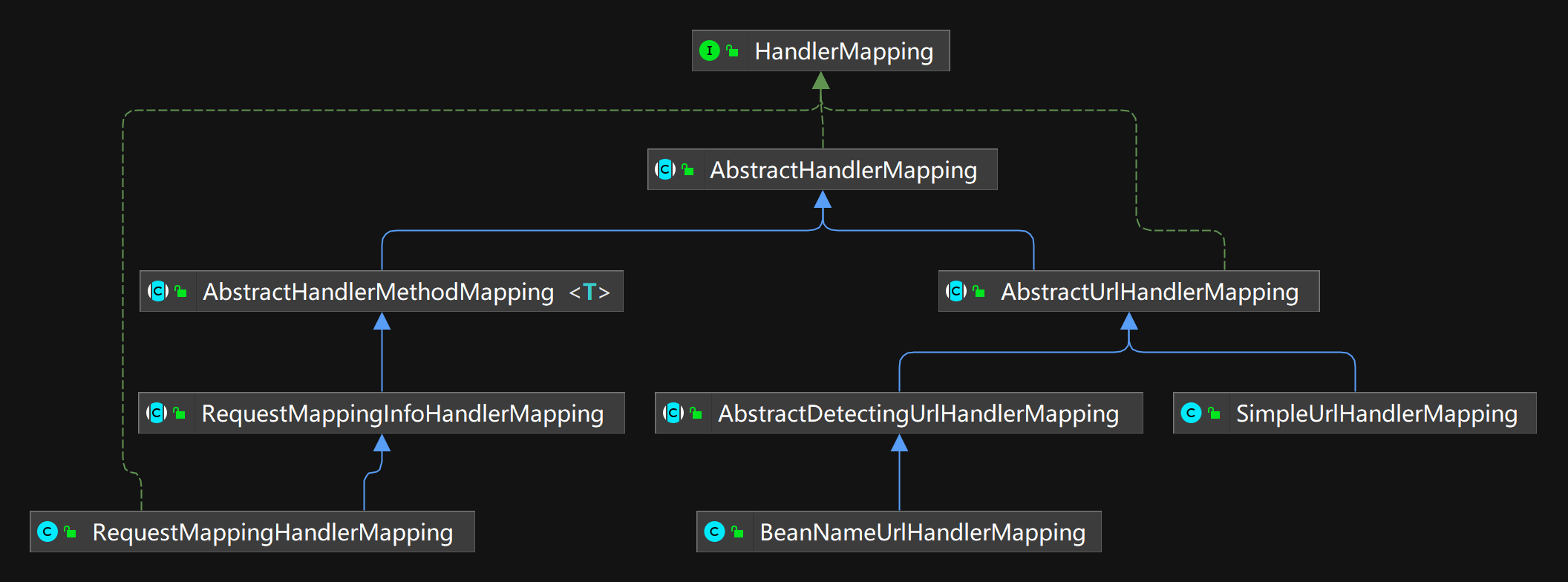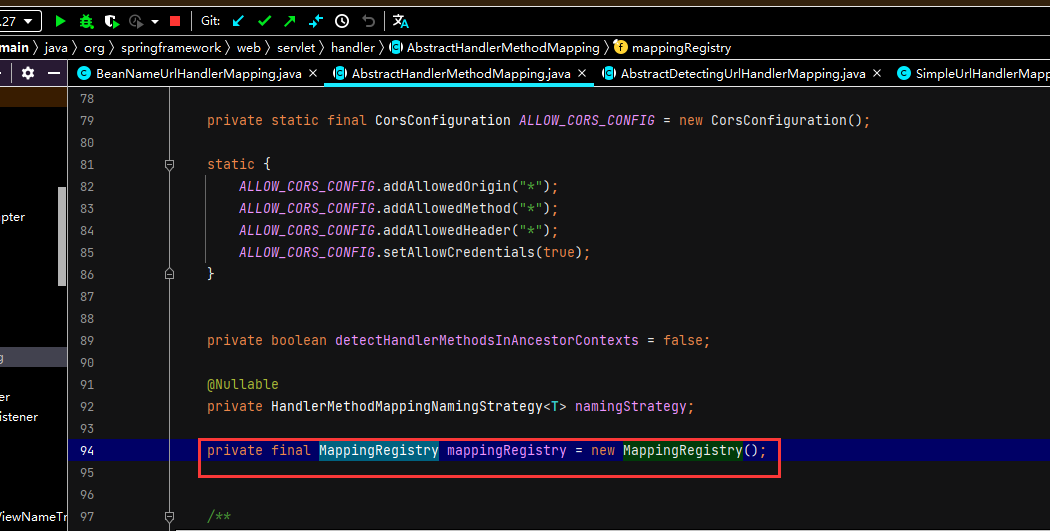12 HandlerMapping详解
SpringMVC中有如下几种默认的handlerMaping:

RequestMappingHandlerMapping继承自AbstractHandlerMethodMapping,BeanNameUrlHandlerMapping和SimpleUrlHandlerMapping继承自AbstractUrlHandlerMapping,他们都继承自AbstractHandlerMapping。
HandlerMapping继承结构如下:

可以看到HandlerMapping 家族的成员可以分为两支,一支继承AbstractUrlHandlerMapping另一支继承AbstractHandlerMethodMapping,而这两个支都继承自抽象类AbstractHandlerMapping.所以本章首先分析AbstractHandlerMapping,然后分别分析AbstractHandlerMethodMapping和AbstractUrlHandlerMapping。
12.1 AbstractHandlerMapping
AbstractHandlerMapping是HandlerMapping的抽象实现,所有HandlerMapping都继承自AbstractHandlerMapping。AbstractHandlerMapping采用模板模式设计了HandlerMapping实现的整体结构,子类只需要通过模板方法提供一些初始值或者具体的算法即可。将AbstractHa-ndlerMapping分析透对整个HandlerMapping实现方式的理解至关重要。在Spring MVC中有很多组件都是采用的这种模式——首先使用一个抽象实现采用模板模式进行整体设计,然后在子类通过实现模板方法具体完成业务,所以在分析Spring MVC源码的过程中尤其要重视对组件接口直接实现的抽象实现类的分析。
HandlerMapping的作用是根据request查找Handler 和 Interceptors。获取Handler 的过程通过模板方法getHandlerInternal交给了子类。AbstractHandlerMapping 中保存了Interceptor,在获取到Handler后会自己根据从request提取的 lookupPath将相应的 Interceptors装配上去,当然子类也可以通过getHandlerInternal方法设置自己的Interceptor,getHandlerInternal 的返回值为Object类型。
AbstractHandlerMapping继承了WebApplicationObjectSupport,初始化时会自动调用模板方法 initApplicationContext,AbstractHandlerMapping 的创建就是在 initApplicationContext方法里面实现的,代码如下:
- AbstractHandlerMapping.java
public abstract class AbstractHandlerMapping extends WebApplicationObjectSupport implements HandlerMapping, Ordered {
...
@Override
protected void initApplicationContext() throws BeansException {
extendInterceptors(this.interceptors);//extendInterceptors是模板方法,用于给子类提供一个添加(或者修改) Interceptors 的入口.不过在现有Spring MVC的实现中并没有使用。
detectMappedInterceptors(this.adaptedInterceptors);//detectMappedInterceptors方法用于将Spring MVC容器及父容器中的所有MappedInter-ceptor类型的 Bean添加到mappedInterceptors属性,代码如下:
/**
protected void detectMappedInterceptors(List<HandlerInterceptor> mappedInterceptors) {
mappedInterceptors.addAll(BeanFactoryUtils.beansOfTypeIncludingAncestors(
obtainApplicationContext(), MappedInterceptor.class, true, false).values());
}
**/
initInterceptors();//initInterceptors方法的作用是初始化Interceptor,具体内容其实是将interceptors属性里所包含的对象按类型添加到mappedInterceptors或者adaptedInterceptors,代码如下:
/**
protected void initInterceptors() {
if (!this.interceptors.isEmpty()) {
for (int i = 0; i < this.interceptors.size(); i++) {
Object interceptor = this.interceptors.get(i);
if (interceptor == null) {
throw new IllegalArgumentException("Entry number " + i + " in interceptors array is null");
}
this.adaptedInterceptors.add(adaptInterceptor(interceptor));
}
}
}
**/
}
...
}
AbstractHandlerMapping有如下相应属性:
public abstract class AbstractHandlerMapping extends WebApplicationObjectSupport implements HandlerMapping, Ordered {
...
private final List<Object> interceptors = new ArrayList<>();
private final List<HandlerInterceptor> adaptedInterceptors = new ArrayList<>();
...
}
Interceptors :用于配置 SpringMVC的拦截器,有两种设置方式:①注册HandlerMapping时通过属性设置;②通过子类的extendInterceptors钩子方法进行设置。Interceptors并不会直接使用,而是通过initInterceptors方法按类型分配到adaptedInterceptors 中进行使用,interceptors只用于配置。
HandlerMapping是通过getHandler方法来获取处理器Handler和拦截器Interceptor的,下面看一下在AbstractHandlerMapping中的实现方法。
- AbstractHandlerMapping.java
@Override
@Nullable
public final HandlerExecutionChain getHandler(HttpServletRequest request) throws Exception {
Object handler = getHandlerInternal(request);
if (handler == null) {
handler = getDefaultHandler();
}
if (handler == null) {
return null;
}
if (handler instanceof String) {
String handlerName = (String) handler;
handler = obtainApplicationContext().getBean(handlerName);
}
HandlerExecutionChain executionChain = getHandlerExecutionChain(handler, request);
if (CorsUtils.isCorsRequest(request)) {
CorsConfiguration globalConfig = this.globalCorsConfigSource.getCorsConfiguration(request);
CorsConfiguration handlerConfig = getCorsConfiguration(handler, request);
CorsConfiguration config = (globalConfig != null ? globalConfig.combine(handlerConfig) : handlerConfig);
executionChain = getCorsHandlerExecutionChain(request, executionChain, config);
}
return executionChain;
}
可以看到getHandler方法的实现共分两部分,getHandlerExecutionChain方法调用前先找Handler,getHandlerExecutionChain方法用于添加拦截器。
找Handler的过程如下:
- 通过getHandlerInternal ( request)方法获取,这是个模板方法,留给子类具体实现(这也是其子类主要做的事情)。
- 如果没有获取到则使用默认的Handler,默认的Handler保存在 AbstractHandlerMapping的defaultHandler中,可以在配置HandlerMapping时进行配置,也可以在子类中进行设置。
- 如果找到的Handler 是String类型,则以它为名到Spring MVC的容器里查找相应的Bean。
getHandlerExecutionChain的过程如下:
protected HandlerExecutionChain getHandlerExecutionChain(Object handler, HttpServletRequest request) {
HandlerExecutionChain chain = (handler instanceof HandlerExecutionChain ?
(HandlerExecutionChain) handler : new HandlerExecutionChain(handler));
String lookupPath = this.urlPathHelper.getLookupPathForRequest(request);
for (HandlerInterceptor interceptor : this.adaptedInterceptors) {
if (interceptor instanceof MappedInterceptor) {
MappedInterceptor mappedInterceptor = (MappedInterceptor) interceptor;
if (mappedInterceptor.matches(lookupPath, this.pathMatcher)) {
chain.addInterceptor(mappedInterceptor.getInterceptor());
}
}
else {
chain.addInterceptor(interceptor);
}
}
return chain;
}
首先使用handler 创建出 HandlerExecutionChain类型的变量,然后将adaptedInterceptors和符合要求的 mappedInterceptors添加进去,最后将其返回。
要想弄明白AbstractHandlerMethodMapping系列,最关键的是要先弄明白AbstractHandlerMethodMapping里三个Map的含义,它们定义如下:
12.2 AbstractHandlerMethodMapping系列(重要)
AbstractHandlerMethodMapping系列是将Method作为Handler来使用的,这也是我们现在用得最多的一种 Handler,比如经常使用的@RequestMapping所注释的方法就是这种Handler,它专门有一个类型:HandlerMethod,也就是Method类型的Handler。
要想弄明白AbstractHandlerMethodMapping系列,最关键的是要先弄明白MappingRegistry:

- AbstractHandlerMethodMapping的内部类
class MappingRegistry {
...
private final Map<T, HandlerMethod> mappingLookup = new LinkedHashMap<>();
private final MultiValueMap<String, T> urlLookup = new LinkedMultiValueMap<>();
private final Map<String, List<HandlerMethod>> nameLookup = new ConcurrentHashMap<>();
...
}
其中泛型T来自于AbstractHandlerMethodMapping类的定义
public abstract class AbstractHandlerMethodMapping<T> extends AbstractHandlerMapping implements InitializingBean {
...
}
mappingLookup:保存着匹配条件(也就是RequestCondition)和 HandlerMethod 的对应关系。
urlLookup:保存着url与匹配条件(也就是RequestCondition)的对应关系。
nameLookup:保存着name与HandlerMethod 的对应关系,它使用的也是 MultiValueMap类型的Map,也就是说一个name可以有多个 HandlerMethod。
AbstractHandlerMethodMapping实现了InitializingBean接口,所以spring容器会自动调用其afterPropertiesSet方法,afterPropertiesSet 又交给initHandlerMethods方法完成具体的初始化,代码如下:
public void afterPropertiesSet() {
initHandlerMethods();
}
protected void initHandlerMethods() {
if (logger.isDebugEnabled()) {
logger.debug("Looking for request mappings in application context: " + getApplicationContext());
}
String[] beanNames = (this.detectHandlerMethodsInAncestorContexts ?
BeanFactoryUtils.beanNamesForTypeIncludingAncestors(obtainApplicationContext(), Object.class) :
obtainApplicationContext().getBeanNamesForType(Object.class));
for (String beanName : beanNames) {
if (!beanName.startsWith(SCOPED_TARGET_NAME_PREFIX)) {
Class<?> beanType = null;
try {
beanType = obtainApplicationContext().getType(beanName);
}
catch (Throwable ex) {
if (logger.isDebugEnabled()) {
logger.debug("Could not resolve target class for bean with name '" + beanName + "'", ex);
}
}
if (beanType != null && isHandler(beanType)) {
detectHandlerMethods(beanName);
}
}
}
handlerMethodsInitialized(getHandlerMethods());
}
首先拿到容器里所有的bean,然后根据一定的规则筛选出Handler,然后获取其中的方法并判断是否满足一定的条件,如果满足一定条件保存到Map里。这里的筛选使用的方法是isHandler,这是一个模板方法,具体实现在RequestMappingHandlerMapping里面,筛选的逻辑是检查类前是否有@Controller或者@RequestMapping注释,代码如下:
protected boolean isHandler(Class<?> beanType) {
return (AnnotatedElementUtils.hasAnnotation(beanType, Controller.class) ||
AnnotatedElementUtils.hasAnnotation(beanType, RequestMapping.class));
}
detectHandlerMethods负责将Handler保存到Map里,handlerMethodsInitialized可以对Handler进行一些初始化,是一个模板方法,但子类并没有实现。下面介绍detectHandlerMethods具体是怎么工作的。
- handlerMethodsInitialized
protected void detectHandlerMethods(Object handler) {
//获取Handler的类型
Class<?> handlerType = (handler instanceof String ?
obtainApplicationContext().getType((String) handler) : handler.getClass());
if (handlerType != null) {
Class<?> userType = ClassUtils.getUserClass(handlerType);
//获取当前beanli所有符合Handler要求的method
Map<Method, T> methods = MethodIntrospector.selectMethods(userType,
(MethodIntrospector.MetadataLookup<T>) method -> {
try {
return getMappingForMethod(method, userType);
}
catch (Throwable ex) {
throw new IllegalStateException("Invalid mapping on handler class [" +
userType.getName() + "]: " + method, ex);
}
});
if (logger.isDebugEnabled()) {
logger.debug(methods.size() + " request handler methods found on " + userType + ": " + methods);
}
methods.forEach((method, mapping) -> {
Method invocableMethod = AopUtils.selectInvocableMethod(method, userType);
registerHandlerMethod(handler, invocableMethod, mapping);
});
}
}
detectHandlerMethods方法分两步:首先从传入的处理器中找到符合要求的方法,然后使用registerHandlerMethod进行注册(也就是保存到Map中)。
在每个HandlerMapping的getHandler函数中,首先会通过Object handler = getHandlerInternal(request);来获取相应的handler,AbstractHanlerMethodMapping的getHandlerInternal方法代码如下:
- AbstractHanlerMethodMapping.java
@Override
protected HandlerMethod getHandlerInternal(HttpServletRequest request) throws Exception {
String lookupPath = getUrlPathHelper().getLookupPathForRequest(request);//"/submit"
...
this.mappingRegistry.acquireReadLock();
try {
HandlerMethod handlerMethod = lookupHandlerMethod(lookupPath, request);
...
}
return (handlerMethod != null ? handlerMethod.createWithResolvedBean() : null);
}
finally {
this.mappingRegistry.releaseReadLock();
}
}
可以看到实际就做了三件事:第一件是根据request 获取lookupPath,可以简单地理解为url;第二件是使用lookupHandlerMethod方法通过lookupPath和 request 找handlerMethod ;第三件是如果可以找到handlerMethod则调用它的createWithResolvedBean方法创建新的HandlerMethod并返回,createWithResolvedBean 的作用是判断handlerMethod里的 handler是不是String类型,如果是则改为将其作为beanName从容器中所取到的bean,不过HandlerMethod里的属性都是final类型的,不可以修改,所以在createWithResolvedBean方法中又用原来的属性和修改后的 handler新建了一个HandlerMethod。下面来看一下具体查找HandlerMethod 的方法 lookupHandlerMethod。
- AbstractHandlerMethodMapping.java
protected HandlerMethod lookupHandlerMethod(String lookupPath, HttpServletRequest request) throws Exception {
//Match是内部类,保存匹配条件和Handler
List<Match> matches = new ArrayList<>();
//根据lookupPath获取到匹配条件
List<T> directPathMatches = this.mappingRegistry.getMappingsByUrl(lookupPath);
if (directPathMatches != null) {
addMatchingMappings(directPathMatches, matches, request);
}
if (matches.isEmpty()) {
// 将找到的匹配条件添加到matches
addMatchingMappings(this.mappingRegistry.getMappings().keySet(), matches, request);
}
//将包含匹配条件的Handler的matches排序,并取第一个作为bestMatch,如果前面两个排序相同则抛出异常
if (!matches.isEmpty()) {
Comparator<Match> comparator = new MatchComparator(getMappingComparator(request));
matches.sort(comparator);
if (logger.isTraceEnabled()) {
logger.trace("Found " + matches.size() + " matching mapping(s) for [" + lookupPath + "] : " + matches);
}
Match bestMatch = matches.get(0);
if (matches.size() > 1) {
if (CorsUtils.isPreFlightRequest(request)) {
return PREFLIGHT_AMBIGUOUS_MATCH;
}
Match secondBestMatch = matches.get(1);
if (comparator.compare(bestMatch, secondBestMatch) == 0) {
Method m1 = bestMatch.handlerMethod.getMethod();
Method m2 = secondBestMatch.handlerMethod.getMethod();
throw new IllegalStateException("Ambiguous handler methods mapped for HTTP path '" +
request.getRequestURL() + "': {" + m1 + ", " + m2 + "}");
}
}
request.setAttribute(BEST_MATCHING_HANDLER_ATTRIBUTE, bestMatch.handlerMethod);
handleMatch(bestMatch.mapping, lookupPath, request);
return bestMatch.handlerMethod;
}
else {
return handleNoMatch(this.mappingRegistry.getMappings().keySet(), lookupPath, request);
}
}
12.3 AbstractUrlHandlerMapping
AbstractUrlHandlerMapping继承自AbstractHandlerMapping,从名字就可以看出它是通过url来进行匹配的,当使用xml配置url映射时会调用此方法。此系列大致原理是将url与对应的Handler保存在一个 Map中,在getHandlerInternal方法中使用url 从 Map中获取Handler,AbstractUrlHandlerMapping 中实现了具体用url 从 Map中获取 Handler的过程,而Map的初始化则交给了具体的子孙类去完成。这里的Map就是定义在AbstractUrlHandlerMapping 中的 handlerMap,另外还单独定义了处理“/”请求的处理器rootHandler,定义如下:
- AbstractUrlHandlerMapping.java
private Object rootHandler;
private final Map<String, Object> handlerMap = new LinkedHashMap<>();
下面看一下具体是怎么获取 Handler的,以及这个Map是怎么创建的。
Handler的入口是getHandlerInternal方法,它在 AbstractUrlHandlerMapping 中代码如下:
@Override
@Nullable
protected Object getHandlerInternal(HttpServletRequest request) throws Exception {
String lookupPath = getUrlPathHelper().getLookupPathForRequest(request);
//从xml中配置的url请求中拿到相应的handler(Controller)
Object handler = lookupHandler(lookupPath, request);
//如果没有获取到,且lookupPath的请求为"/"则使用rootHandler,如果不是则创建默认的handler,如果没有配置默认的handler则返回null
if (handler == null) {
Object rawHandler = null;
if ("/".equals(lookupPath)) {
rawHandler = getRootHandler();
}
if (rawHandler == null) {
rawHandler = getDefaultHandler();
}
if (rawHandler != null) {
// 如果是String类型则到容器中查找具体的Bean
if (rawHandler instanceof String) {
String handlerName = (String) rawHandler;
rawHandler = obtainApplicationContext().getBean(handlerName);
}
// 用来校验找到的Handler和request是否匹配,是模板方法,而且子类也没有使用
validateHandler(rawHandler, request);
handler = buildPathExposingHandler(rawHandler, lookupPath, lookupPath, null);
}
}
if (handler != null && logger.isDebugEnabled()) {
logger.debug("Mapping [" + lookupPath + "] to " + handler);
}
else if (handler == null && logger.isTraceEnabled()) {
logger.trace("No handler mapping found for [" + lookupPath + "]");
}
return handler;
}
lookupHandler方法用于使用lookupPath 从 Map中查找Handler,不过很多时候并不能直接从Map中 get到,因为很多Handler都是用了Pattern的匹配模式,如“/show/article/*”,这里的星号可以代表任意内容而不是真正匹配url中的星号。另外,一个url还可能跟多个Pattern相匹配,这时还需要选择其中最优的,所以查找过程其实并不是直接简单地从Map里获取,单独写一个方法来做也是应该的。lookupHandler的代码如下:
- AbstractUrlHandlerMapping.java
//urlPath的形式为:/submit
protected Object lookupHandler(String urlPath, HttpServletRequest request) throws Exception {
// 直接从Map中获取
Object handler = this.handlerMap.get(urlPath);
if (handler != null) {
// 如果是String类型则从容器中获取
if (handler instanceof String) {
String handlerName = (String) handler;
handler = obtainApplicationContext().getBean(handlerName);
}
validateHandler(handler, request);
return buildPathExposingHandler(handler, urlPath, urlPath, null);
}
// 进行匹配
List<String> matchingPatterns = new ArrayList<>();
for (String registeredPattern : this.handlerMap.keySet()) {
if (getPathMatcher().match(registeredPattern, urlPath)) {
matchingPatterns.add(registeredPattern);
}
else if (useTrailingSlashMatch()) {
if (!registeredPattern.endsWith("/") && getPathMatcher().match(registeredPattern + "/", urlPath)) {
matchingPatterns.add(registeredPattern + "/");
}
}
}
String bestMatch = null;
Comparator<String> patternComparator = getPathMatcher().getPatternComparator(urlPath);
if (!matchingPatterns.isEmpty()) {
matchingPatterns.sort(patternComparator);
if (logger.isDebugEnabled()) {
logger.debug("Matching patterns for request [" + urlPath + "] are " + matchingPatterns);
}
bestMatch = matchingPatterns.get(0);
}
if (bestMatch != null) {
handler = this.handlerMap.get(bestMatch);
if (handler == null) {
if (bestMatch.endsWith("/")) {
handler = this.handlerMap.get(bestMatch.substring(0, bestMatch.length() - 1));
}
if (handler == null) {
throw new IllegalStateException(
"Could not find handler for best pattern match [" + bestMatch + "]");
}
}
if (handler instanceof String) {
String handlerName = (String) handler;
handler = obtainApplicationContext().getBean(handlerName);
}
validateHandler(handler, request);
String pathWithinMapping = getPathMatcher().extractPathWithinPattern(bestMatch, urlPath);
// 之前是通过sort方法进行排序,然后拿第一个作为bestPatternMatch,不过有可能有很多个Pattern的权重相同,这里就是处理这种情况
Map<String, String> uriTemplateVariables = new LinkedHashMap<>();
for (String matchingPattern : matchingPatterns) {
if (patternComparator.compare(bestMatch, matchingPattern) == 0) {
Map<String, String> vars = getPathMatcher().extractUriTemplateVariables(matchingPattern, urlPath);
Map<String, String> decodedVars = getUrlPathHelper().decodePathVariables(request, vars);
uriTemplateVariables.putAll(decodedVars);
}
}
if (logger.isDebugEnabled()) {
logger.debug("URI Template variables for request [" + urlPath + "] are " + uriTemplateVariables);
}
return buildPathExposingHandler(handler, bestMatch, pathWithinMapping, uriTemplateVariables);
}
// 没有找到Handler,返回null
return null;
}